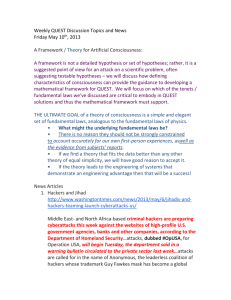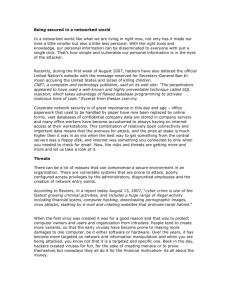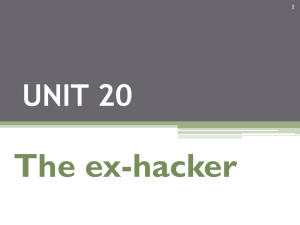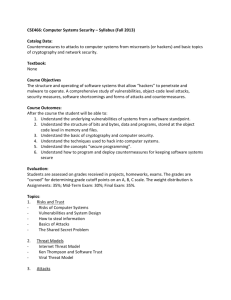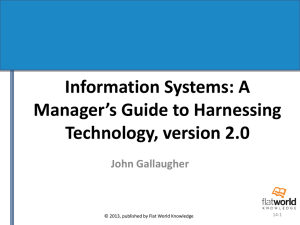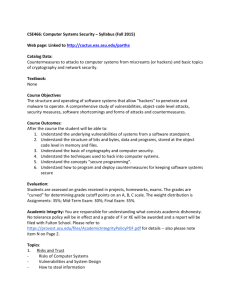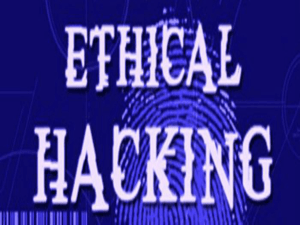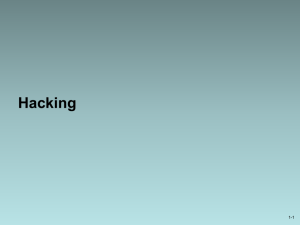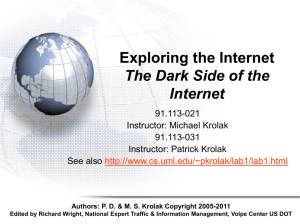security-frmwrk
advertisement
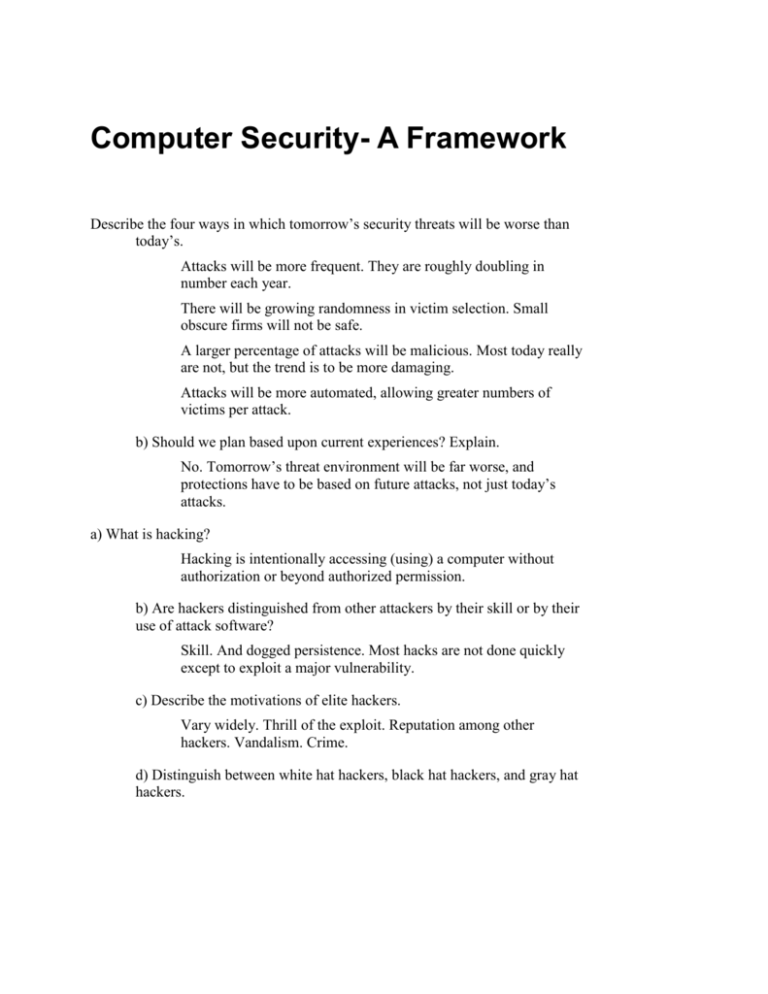
Computer Security- A Framework Describe the four ways in which tomorrow’s security threats will be worse than today’s. Attacks will be more frequent. They are roughly doubling in number each year. There will be growing randomness in victim selection. Small obscure firms will not be safe. A larger percentage of attacks will be malicious. Most today really are not, but the trend is to be more damaging. Attacks will be more automated, allowing greater numbers of victims per attack. b) Should we plan based upon current experiences? Explain. No. Tomorrow’s threat environment will be far worse, and protections have to be based on future attacks, not just today’s attacks. a) What is hacking? Hacking is intentionally accessing (using) a computer without authorization or beyond authorized permission. b) Are hackers distinguished from other attackers by their skill or by their use of attack software? Skill. And dogged persistence. Most hacks are not done quickly except to exploit a major vulnerability. c) Describe the motivations of elite hackers. Vary widely. Thrill of the exploit. Reputation among other hackers. Vandalism. Crime. d) Distinguish between white hat hackers, black hat hackers, and gray hat hackers. White hat hackers hack but tell the systems administrator about vulnerabilities. Black hats hack but do not help the victim systems administrator. Grey hats do both. Sometimes, paid attackers doing vulnerability testing are called white hat hackers. e) What are ethical hackers? These are hackers who have codes of ethics. These codes usually some actions which allow many victims would call harm. f) Are white hat hacking and ethical hacking defenses against criminal prosecution? No. Hacking is still a crime unless the victim authorizes the hack. a) What do you think are the motivations of virus writers? Sometimes the thrill of being able to do it. Sometimes a desire to harm. b) Virus releasers? (You will need to draw your own conclusions to answer these questions.) Virus releasing, not virus writing, is a crime. Intent to do harm. Thrill of watching the damage. a) Who are script kiddies? Hackers with modest technical skills who use attack scripts (kiddie scripts) created by more experienced attackers. b) What makes them dangerous? There are many of them, and their kiddie scripts are potent. c) Why are corporations often unwilling to prosecute script kiddies? Potential loss of reputation. Cost of prosecution. Many script kiddies are minors who would not receive serious sentences. a) List the major types of criminal attacks. Credit card and identity theft Stealing trade secrets (intellectual property) Extortion b) Distinguish between stealing credit cards and identity theft. Page 2 In credit card number theft, the attacker steals credit card numbers and uses them to make unauthorized purchases. In identity theft, the thief steals enough personal information about a person to set up fake bank accounts, get credit cards, and do other major financial transactions in the victim’s name. a) Why are corporate employees especially dangerous? They have knowledge of the system and access permissions. b) What kinds of attacks do they perpetrate? Sabotage, financial theft, theft of trade secrets c) Why are corporate IT and security staffs especially dangerous? The have specialized knowledge and access permissions. Many computer crimes are committed by corporate IT and security staff members. 1. What are the main types of attacks? Physical access attacks Dialog attacks Penetration attacks (scanning or probing, break-in or hacking, denial-of-service, malware viruses and worms) Social engineering a) What is the purpose of wiretaps? To tap into conversations to steal information (Not mentioned in the text: To get unauthorized Internet access) b) How have wireless LANs made wiretapping easier? Signals extend beyond the corporate premises, so wiretappers can lurk outside the company’s grounds c) Why is password cracking difficult if you do not have physical access to the computer? Usually, you are locked out after a few guesses. a) What is social engineering? Social engineering is tricking an employee into giving out information or taking an action that reduces security or harms a system b) How can it be stopped? Page 3 Training and enforcement 3. a) an attacker-in-the-middle attack? When the attacker can intercept messages passing between two communicating parties. b) eavesdropping? Reading messages sent between two parties. c) How is eavesdropping thwarted? By encrypting messages. d) What is confidentiality? Protection against the reading of intercepted messages. e) What is impersonation? Pretending to be someone else when sending messages. f) What is authentication? Requiring communication partners to prove their identity. g) What is message integrity? The assurance that the receiver will be able to detect any changes made en route. h) What is a cryptographic system? A cryptographic system is a system that automatically implements confidentiality, authentication, integrity, and other safeguards as a package. Briefly describe the four types of penetration attacks. Scanning (probing) attacks Break-in (hacking) attacks Denial-of-service attacks Malware (viruses and worms) 4. Why is security primarily a management issue, not a technology issue? Page 4 Without correct strategy and implementation, technology will do little good. What is top-to-bottom security? There must be commitment to security from top management to the lowest levels of the firm. b) Why is the enforcement of security policies through the sanctioning of violators important? You get what you enforce. If you do not enforce rules, they will not be followed. What is comprehensive security? Closing all avenues of attack. Describe defense in depth. Attacker must break through multiple defenses to be successful What are security audits, and why are they crucial for comprehensive security? Security audits test all avenues of attacks to ensure that defenses are working. Without security audits, a company will not know if it has comprehensive security. What costs do firms weigh in risk analysis? The costs of both attacks and defenses How is threat severity computed? Cost of a successful attack times the probability of a successful attack. How is the value of protection computed? Threat severity minus the cost of protections Why is prioritization important, and how is it done? Companies have limited resources. Must spend on countermeasures with the highest value of protection. 5. Why are security policies important? Page 5 Security policies govern individual actions. 6. Create three corporate security policies. These policies should be specific. Otherwise, there would be ambiguity in their application. Home computers connected remotely to the corporate network must have antivirus programs updated daily. Passwords must be changed every sixty days and must not be passwords used previously. Each firewall log must be examined daily for at least an hour. Page 6
